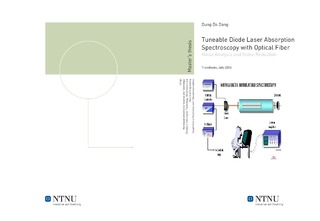| dc.description.abstract | A prototype of a fiber based absorptionspectroscopy instrument is built. A single mode fiber pigtailDistributed Feedback laser (DFB) is used to scan a known$mbox{NH}_3$ absorption line near $1512nm$ ($6614cm^{-1}$). $2mm$diameter InGaAs PIN photodiodes are used to convert the light signalto electrical signals by use of special designed transimpedanceamplifiers. Laser modulation, coherent detection at twice themodulation frequency (second harmonic detection), other electronics,and digital signal processing are provided by Norsk Elektrooptikk.bigskip The DFB laser from NEL (NLK1S5EAAA) delivers 10mW fiberoutput and has maximum output around 30mW at maximum injectioncurrent of 200mA. This laser was found to be very quiet at dcoperation. However, in wavelength modulation spectroscopy operationit exhibit large modulation noise that was found to stem from thefiber coupling inside the laser module. A detection limit of$6times10^{-5}$ to $1times10^{-4}$ in absorbance unit with 0.712moptical path length and an effective measurement bandwidth of 52Hzwas achieved by this laser. This is significantly above thedetection limit with free air lasers which achieve $3times10^{-6}$relative absorbance (0.15ppm $mbox{NH}_3$ at room temperature andatmospheric pressure). The acquisition time for each concentrationmeasurement takes 3.2s. Hence, the response time is very fast whichis a common property of wavelength modulation spectroscopy.bigskip The modulation noise problem was attacked by an electronicnoise cancellation scheme. The idea was that since the noise sourceis inside the laser module and no external optical component can beused to reduce it. With great linearity and reliability propertiesof fused biconical taper (FBT) couplers the laser beam is split intotwo identical beams with nearly equal amount of the same noise. Onebeam, signal beam, is used to induce second harmonic signals in thegaseous path. The other beam goes directly to an identicalphotodetector and is used as a reference signal. Two specialdesigned noise canceller circuits were built to remove commonsignals. Both the circuits, based on current subtraction (notoptimized) or voltage subtraction, give comparable results. Themodulation noise was reduced by more than 12dB. A detection limit of$5times10^{-6}$ was achieved with this prototype. Even aftertransmitting the laser beam through a 3200 meter single mode fiber asignal to noise ratio (relative to 100ppm signal) of $180times$.Hence, a sensitivity is $1.1times10^{-5}$ in absorbance unit wasachieved with the basic noise canceller (not optimized). Thiscorresponds to a detection limit of 0.55ppm ammonia (12.5ppm withoutcancellation). The optimized noise canceller could reduce this by afactor of 3 or more.bigskipThe basic noise canceller based on current domain subtraction wasinvestigated in detail and optimized. This new circuit suppressedthe intensity modulation signal by more than 70dB. The 2f noise wasreduced to approximately 50ppb or $1.1times10^{-6}$ in absorbanceunit with an effective noise bandwidth of 52.3Hz and 1m optical pathlength. This is a record sensitivity with such simple electronics.The sensitivity of our fiber based prototype is limited by thefluctuating etalon fringing in the signal beam. Under normaloperation the prototype achieves approximately $pm20$ppb zero pointdrift in the concentration with an acquisition time of 48s (3.5Hznoise bandwidth). By our knowledge these results are the bestavailable and are competitive with the much more complex frequencymodulation spectroscopy technique.bigskipThese balanced transimpedance amplifiers also have the ability tomeasure the absorption spectra directly without modulation.Determining the absorption linewidth and its shape is now a straightforward task. By use of dual beam configuration and noisecancellation thermal effects that caused background fluctuationswere greatly suppressed. The laser delivers high intensity light,$sim22mW$. The dominating noise is the photocurrent shot noise andthe etalon fringing from optical components in the signal path.Remote sensing, in-situ, noninvasive measurements can be performedwith this instrument. In some cases it's flexibility, and remotesensing possibility are of great attractiveness for the industry.The sensitivity is also improved by a factor of two with the fiberbased tuneable diode laser absorption spectroscopy instrument.bigskipIn the end of this thesis we demonstrate the ability to measuremultiple absorption lines simultaneously. The number of measurementpaths is limited by the laser output power. | nb_NO |

